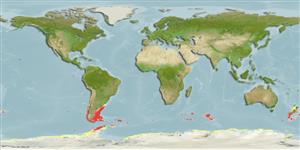Ascidiacea |
Stolidobranchia |
Styelidae
Environment: milieu / climate zone / depth range / distribution range
Ecology
Sessile; depth range 0 - 320 m (Ref. 1662). Temperate
Southwest Atlantic, Southern Pacific and the Antarctic: From Antarctica to sub-Antarctic islands, New Zealand and South America.
Length at first maturity / Size / Weight / Age
Maturity: Lm ? range ? - ? cm
Minimum depth from Ref. 3435. Known from depths of 0 to 200 m (Ref. 3435), on hard substrate like pebbles, wood, sticks, rocks, valves, or polychaetes (Ref. 87801).
Life cycle and mating behavior
Maturity | Reproduction | Spawning | Eggs | Fecundity | Larvae
Members of the class Ascidiacea are hermaphroditic; both cross- and self-fertilization is typical. Life cycle: Eggs develop into lecithotrophic larva before metamorphosing into benthic adults.
Sanamyan, K.E. and N.P. Sanamyan 1999 Some benthic Tunicata from the southern Indo-Pacific Ocean. Journal of Natural History 33:1835-1876. (Ref. 1662)
IUCN Red List Status
(Ref. 130435: Version 2025-1)
CITES status (Ref. 108899)
Not Evaluated
Not Evaluated
Threat to humans
Human uses
| FishSource |
Tools
More information
Trophic EcologyFood items (preys)
Diet composition
Food consumption
Predators
Population dynamicsGrowthMax. ages / sizesLength-weight rel.Length-length rel.Length-frequenciesMass conversionAbundance Life cycleReproductionMaturityFecunditySpawningEggsEgg developmentLarvae PhysiologyOxygen consumption
Human RelatedStamps, coins, misc.
Internet sources
Estimates based on models
Preferred temperature
(Ref.
115969): 4.1 - 12.1, mean 7.3 (based on 475 cells).
Price category
Unknown.
